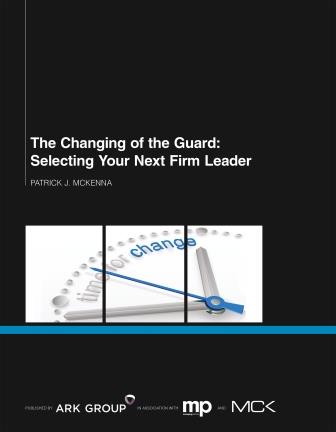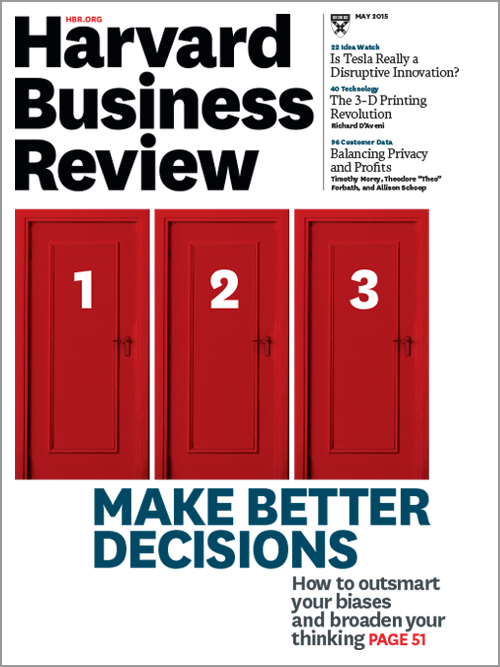http://www.patrickmckenna.com/blog
Page << Prev 20 21 22 23 24 25 26 27 28 29 Next >> of 95
Post #742 – Tuesday,
September 8, 2015
The Fall 2015 Issue of International Review
Is Now Available
INTERNATIONAL REVIEW is my 24-page glossy, printed
magazine distributed to over 1600 law firm chairs and managing partners
throughout North America.
We
start with some prescriptive counsel on how your industry groups need to better
Understand
Industry Dynamics in order to be successful, and then continue with a
reminder of how you need to Schedule Time For Strategic Thinking
as it could arguably be the most important activity in your leadership role.
While
I have never been a fan of “branding” and watched over the years as numerous
law firms have wasted incredible monetary resources in various expensive
advertising experiments, I am nevertheless going to stick my neck out and
suggest that The Value In Developing A Leadership Brand is there for every
firm leader to employ.
Pages 12 and 13 are
intended to introduce you to my newest work, The Changing of The Guard:
Selecting Your Next Firm Leader, and How New Managing Partners Can
Avoid Being Blindsided is a related one-on-one interview with the
Editor of Managing Partner Magazine.
How Effective Leaders Delegate has its origins in a survey that I send out
to new managing partners, after their First 100 Days (see back cover) inquiring
about their most unexpected challenges and the last piece, Why Law Firms Need Non-Executive
Directors is included to provoke your thinking about a trend that has
been paying dividends for UK and Australian law firms for a few years now.
As always, I sincerely hope that you find some practical
ideas, tips and techniques here that you can put to use immediately.
Please send me your observations, critiques, comments and suggestions with
respect to any of these articles.
Click on the Cover to download your complimentary PDF copy of
the magazine.
Post #741 – Tuesday,
September 1, 2015
2020 Vision: The Future of Legal Services
 I’m pleased to have
contributed two separate chapters to this new 116-page Ark report designed to help law firm leaders assess the lay of the legal
landscape, prepare for foreseeable change, and above all to position themselves
so that they are ready to respond to the unseen challenges and opportunities
ahead. I’m pleased to have
contributed two separate chapters to this new 116-page Ark report designed to help law firm leaders assess the lay of the legal
landscape, prepare for foreseeable change, and above all to position themselves
so that they are ready to respond to the unseen challenges and opportunities
ahead.
Wind back the clock 20 years or so to when law
firms held all the cards. At that time,
clients paid an hourly rate with few complaints, allowing firms to work as they
chose, and those clients were loyal. Lawyers specialized right out of law
school, and were prepared to work round the clock for a shot at the brass ring
of partnership. What is now known as the “traditional” law firm business model
was then the only one, and that model made money. In the decade leading up to
the economic downturn, revenues in the legal sector grew steadily every year.
All that has changed.
Now, firms are operating in a “buyers” market,
with non-traditional competitors and new technologies encroaching on what was
once the sole province of traditional firms; endemic overcapacity threatens
those firms’ profitability; and clients spread available work across a variety
of providers – or keep it in house. Moreover, a new generation of “millennial”
lawyers is now well established in the profession – and they have very
different expectations about working styles, workplace culture, and job
longevity.
For better or worse, the legal industry has
changed radically over the past two decades – arguably more so than it had done
in the previous century. What is more, the pace of change continues to
accelerate as new technologies develop, and client businesses – already ahead
of their law firms when it comes to embracing technology and streamlining processes – demand certain efficiencies as a
prerequisite for sending work a law firm’s way. The speed of evolution is such
that, looking just five years into the future, we can predict even more major
changes for law firms.
In this fast-moving, competitive, increasingly
varied environment, only the most agile firms – those able to respond rapidly
to future trends – are likely to succeed. 2020 Vision: The Future of Legal
Services brings together the advice of leading industry practitioners and
consultants who scan the legal horizon for indicators of change, offer their
predictions, and share experience and practical guidance to help law firm
leaders prepare for what is coming up next.
For more information
on this publication - click here
Post #740 – Tuesday,
August 18, 2015
A Lucrative Industry
Segment
 There are 10,000 baby boomers turning
65 every day -- and every day for the next 14 years. Older people are heavier users of hospitals,
as you'd expect. But there's a certain subset that's
growing faster than full-service hospitals: ambulatory surgical centers (ASCs).
These facilities focus on same-day
surgical care. So they'd do laparoscopic surgery on your knee, but not
open-heart surgery. There are 10,000 baby boomers turning
65 every day -- and every day for the next 14 years. Older people are heavier users of hospitals,
as you'd expect. But there's a certain subset that's
growing faster than full-service hospitals: ambulatory surgical centers (ASCs).
These facilities focus on same-day
surgical care. So they'd do laparoscopic surgery on your knee, but not
open-heart surgery.
ASCs are a $35 billion fast-growing
industry. The trend is toward more
outpatient procedures at ASCs. Twenty
years ago, 30% of all surgeries were outpatient. Today it's 70%.
A well-run business in this sector
prints money. For any procedure, there
are three fees for the patient. There is
a fee paid to the physician, billed by physician. There is an anesthesiology fee, billed by the
anesthesia provider. And there is a
facility fee for use of the facility. It's that last fee an ASC collects, paid by
the patient's insurer. And it's
high-margin. A foot operation can cost
as little as $1,000, but the ASC collects as much as $20,000.
To really understand what I’m talking
about in this post, read my article: Understanding Industry Dynamics wherein I
make the point amongst a number of others, that there is no such thing as a
Health Care lawyer.
Post #739 – Friday, July 24, 2015
Some of My Most Recent Articles
 I have written and published a number of articles recently, some of which may not appear on my website. Should you have an interest in any of these titles and wish to obtain a copy of the article, please feel free to send me a note – patrick@patrickmckenna.com I have written and published a number of articles recently, some of which may not appear on my website. Should you have an interest in any of these titles and wish to obtain a copy of the article, please feel free to send me a note – patrick@patrickmckenna.com
Firm Strategy: Understanding Industry Dynamics [Part One] - article
Bloomberg BigLaw Business (bol.bna.com) - July 2015
When Is A Partner Not A Partner? - article contribution
BeatonCapital.com [Australia] - July 2015
Strategic Accountability - co-authored article
Of Counsel, The Legal Practice and Management Report - July 2015
Admitting You're Wrong - co-authored article
American Lawyer magazine - June 2015
Where Do You Spend Your Leadership Time? - Thought Leadership Column
Law Practice Management, Legal Executive Institute - June 2015
A Response to Harvard Study on Collaboration - article
Bloomberg BigLaw Business (bol.bna.com) - June 2015
4 Ways You Can Become Your Client's Favorite Firm - interview contribution
Law360.com - June 2015
The Leadership Succession Process: Identifying, Developing, Electing - article
Of Counsel, The Legal Practice and Management Report - June 2015
Succession Strategies - a critique of my Changing Of The Guard book
Of Counsel, The Legal Practice and Management Report - June 2015
Mistakes To Avoid As A New Firm Leader - Thought Leadership Column
Law Practice Management, Legal Executive Institute - May 2015
Breaking Down Barriers to Collaboration - commentary
Harvard Business Review - May 2015
Patrick McKenna On How New Managing Partners Can Avoid Being Blindsided - Feature Interview
Managing Partner Magazine [UK] - May 2015
Why Law Firms Need Non-Executive Direcotrs - Thought Leadership Column
Law Firm Management, Legal Executive Institute - May 2015
A Key Performance Issue - article
Of Counsel, The Legal Practice and Management Report - May 2015
Going All In On Industry Group Model - interview contribution
Of Counsel, The Legal Practice and Management Report - May 2015
Post #738 – Friday, July 3, 2015
Is Your
Firm Facing A Leadership Transition?
 Do these sound like some of the questions that all new Firm
Leaders are likely to be asking themselves: Do these sound like some of the questions that all new Firm
Leaders are likely to be asking themselves:
• Am I really clear on the reasons why I accepted this position?
• How can I be sure that I have correctly understood what is
expected of me?
• Which tasks should be a priority and which can be put on hold?
• Who am I going to meet with first and what am I going to say?
• Have I defined the challenges facing my firm and determined an
approach to dealing with them?
• When can I begin to introduce change and what is my
initial plan of action?
• How do I make sure that I have the support I need from the
partnership?
If you are (or know of a firm that is) facing a firm leadership
transition or even introducing a new office managing partner taking charge of a
larger office, please have a look at www.first100daysmasterclass.com.
The next program is scheduled for Thursday, August 13, 2015, at
Gleacher Center, the University of Chicago, and we are now accepting
registrations. Have a look at the day's agenda, the faculty, the testimonials,
and extensive course materials, the follow-up support and your total
satisfaction guarantee.
Thus far, over 70 firm chairs and managing partners have
experienced and can attest to the value and benefits of the program--including
leaders from notable AmLaw 100 and AmLaw200 law firms. In fact, we received
these gracious comments from a couple of those attending our First 100 Days
session:
"I was struck by the synthesis of the issues you presented.
It was amazingly clear and comprehensive, given the breadth of the topic and
the short time available. I was delighted to attend the event and I learned a
lot from it."
Hugh Verrier, Chairman - WHITE & CASE
"The First 100 Days Master Class was concise and
insightful. I quickly learned the difference between being a practitioner and a
Firm Leader. I was thoroughly impressed with the scope of the topics
discussed."
ONE YEAR LATER - "I continually refer to that one-day class
as the best thing I did to prepare for my new role."
Vincent A. Cino, Chairman - JACKSON LEWIS
Few experiences can be as overwhelming as taking on the firm
leadership role for the first time. We repeatedly hear about how everything
changes in unexpected ways. It is not about shifting from being an office head
or member of the executive committee to the next rung on some leadership
ladder; it's a quantum leap into a new reality. Brand new Firm Leaders need all
of the practical, impartial, and time-tested advice they can get.
Post # 737 – Thursday, June
11, 2015
New Book Offers Practical, Insightful Advice on
Succession Planning
I am indebted to Steve
Taylor for his gracious review of my latest work. Here is an excerpt:
 Patrick
J. McKenna’s latest book, The Changing of the Guard: Selecting Your Next Firm
Leader, may be the most comprehensive text on law firm succession ever
written, covering every priority from choosing a nominating committee to
defining leadership criteria. Patrick
J. McKenna’s latest book, The Changing of the Guard: Selecting Your Next Firm
Leader, may be the most comprehensive text on law firm succession ever
written, covering every priority from choosing a nominating committee to
defining leadership criteria.
It’s
worth highlighting some points that McKenna makes in his thorough and
informative guidebook—and that’s really what it is: a succession bible. He really covers all the bases, from
selecting a nominating committee with the right composition and setting
selection criteria for the next leader, to developing and implementing a
transition and integration plan to usher out the former chair or managing
partner gracefully and usher in the new one.
And, he offers guidance on all of the many steps in between.
The
biggest value of The Changing of the Guard is the way it helps show how
best to pass the leadership baton. To use another metaphor, it serves as a beacon
to navigating through the rocky waters of succession planning.
Excerpted
from Critique written by: Stephen T. Taylor, Senior Editor
Of
Counsel, The Legal Practice and Management Report - Vol.34
• No. 6 • June 2015
Post #736 – Monday, June 1, 2015
Why Do
Leaders Find It Hard To Say I’m Sorry?
 Even the smartest leaders often find it hard to swallow
their pride and say the simple words, “I was wrong” when they have made a
mistake. Yet executives who cannot openly assume responsibility for
flawed decisions can never correct these mistakes or successfully change
direction, wrote Harvard Professor Rosabeth
Moss Kanter. And the implications of poor judgment get worse the
longer denial continues, she warned. Even the smartest leaders often find it hard to swallow
their pride and say the simple words, “I was wrong” when they have made a
mistake. Yet executives who cannot openly assume responsibility for
flawed decisions can never correct these mistakes or successfully change
direction, wrote Harvard Professor Rosabeth
Moss Kanter. And the implications of poor judgment get worse the
longer denial continues, she warned.
The simple sentence "I was wrong" is the hardest
for leaders to utter and the most necessary for them to learn. If a
leader cannot admit being wrong in a timely fashion, he or she can never
correct mistakes, change direction, and restore success. The consequences
get worse the longer denial prevails.
The arrogance of success is well-known. Powerful
people start to believe that they are above the rules, that what applies to
ordinary people does not apply to them. That's how officials get into
trouble in the first place, using their power to suppress criticism. They
never have to say "I was wrong," because everyone conspires to hide
mistakes. The best leaders manage the risk that they could be wrong by
surrounding themselves with people are smarter than they are, at least in some
things. They create conversations, weigh facts, listen to arguments, and
then make better-informed and less self-serving decisions.
Perhaps apology training will become a growth
business. Actually, I hope not. But I do hope that smart leaders
will be more alert to problems, and if mistakes are made, they can utter the
three magic words and take corrective action.
For more on this subject you might
find my co-authored article in the brand new June issue of American Lawyer Magazine of interest – Admitting You’re Wrong: Why you made that strategic mistake – and how to recover from it.
Post #735 – Friday, May 15,
2015
Structure Your Practice Groups For Performance
 I
had an interesting and lengthy telephone discussion the other day with some
folks from a 500-attorney firm spread over a dozen offices. They related
to me how they have now changed out all of their practice group leaders to newer
and younger candidates. And they were telling me about all of the
internal training that they have been conducting - from developing internal tutorials
(on staffing and financial reports) to bringing in some expert on cultural
competence (what ever that means?) to Professor Heidi Gardner to speak to them
on collaboration (see her latest article in the March HBR and my Blog Rant #733). They then reported that some of these
activities, unfortunately, seem to have generated less than glowing feedback. I
had an interesting and lengthy telephone discussion the other day with some
folks from a 500-attorney firm spread over a dozen offices. They related
to me how they have now changed out all of their practice group leaders to newer
and younger candidates. And they were telling me about all of the
internal training that they have been conducting - from developing internal tutorials
(on staffing and financial reports) to bringing in some expert on cultural
competence (what ever that means?) to Professor Heidi Gardner to speak to them
on collaboration (see her latest article in the March HBR and my Blog Rant #733). They then reported that some of these
activities, unfortunately, seem to have generated less than glowing feedback.
When
I inquired as to why they thought that was the reaction, they reported that it would
seem that these new practice group leaders wanted some pragmatic guidance on
what the job of being a practice leader was really all about, some basic leadership
skills, some help in determining how to balance their producer/manager roles,
and some “substantive take-aways”
(rather than just theoretical lectures). Can you imagine?
Of
course I asked some fundamental questions – questions like whether these new
practice leaders had been given written job descriptions and whether they had any
clarity around how much specific non-billable time they would be expected to
devote to their new leadership roles. And the resounding answer was . . .
“No!”
So
much for the fresh start, or for their experiment in getting PGL 2.0 on track
within this particular firm.
But
the real tragedy? After the call, when I
happened to check my files I noticed that my notes indicated an almost
identical discussion, with a different cast of characters from this same firm,
in November 2003 as they attempted to get serious about “launching a more effective practice group structure.” Now that is sad.
For my part, I’m becoming
obsessive about trying to help firms get this right. So, if you are interested in learning more
about how to effectively address this issue in your firm, come and join me at
our Ark hosted Webinar on June 4 – Law Firm Practice Management 2.0: Identifying and Implementing the Structural Neccessities for Effective Practice Management.
Rant #734 – Monday, May 11,
2015
Why Law Firms Need Non-Executive Directors
 Until
recently and certainly before the failure of Howrey and then Dewey &
LeBoeuf, the bankruptcy of a large law firm had been regarded as nearly
inconceivable. In examining what went
off track and in my article, Malignant Leadership, I reported that: too
often, boards and/or executive committees facilitate firm failures by denying,
overlooking, or ‘working around’ crucial issues. Until
recently and certainly before the failure of Howrey and then Dewey &
LeBoeuf, the bankruptcy of a large law firm had been regarded as nearly
inconceivable. In examining what went
off track and in my article, Malignant Leadership, I reported that: too
often, boards and/or executive committees facilitate firm failures by denying,
overlooking, or ‘working around’ crucial issues.
In
that same piece I cited a number of governance steps that firms might consider.
One of the notable differences between
the top U.K. law firms and top U.S. firms is that almost one-in-four (24%) of
the U.K. firms now employ one or more Non-Executive Directors (NED) on their
boards. Even more interesting, in a
study released late last year, those law firms with at least one NED have seen
revenues grow by one-third more than those without. In yet another research study, this one commissioned by
BDO and published in April: Nearly one-third (33%) of the global firms had at
least one NED on their board.
Law
firm NEDs have often been drawn from a pool of retired law firm leaders,
accountants and management consultants. None
of the U.S. firms surveyed had any independent advisers involved in their
firms’ governance. U.S. lawyers continue
to be skeptical about the value an outside expert might bring. Yet, the use of non-executive directors has
grown significantly. Lovells was known to have appointed the first
non-executive director back in the early 1990s and attested to the benefits of
taking such a move. In raising this
topic with Fred Lautz, Managing Partner at
480-lawyer Quarles & Brady, he offered this observation:
We have assembled a few partners who we call investment partners. They
are attorneys who were partners in the firm at one time, and then went on to
become business executives. After retiring or otherwise completing their
executive roles, some of them have been willing to commit some portion of their
time, under contract, to assist us in business development. We ask them to
leverage their significant business contacts and community and business
profiles to help position us to be in front of developing legal needs which fit
our strategic imperatives. I frequently confer with a number of these investment
partners on matters of firm business, service delivery, client relationships
and Firm growth. I find their experiences in the business side of things (and
in some cases as purchasers of outside legal services), coupled with their
knowledge not only of the business and operations of a professional partnership
generally, but of ours in particular, provide terrific perspective and insight
for me as I lead our Firm. So, while we have not formalized any advisory board
of outside business folks, I can certainly affirm the value of tapping into
people with this type of experience.
I
believe an NED can provide any law firm with a number of benefits, such as:
•
providing a dispassionate external view of the firm together with
business experience and new concepts;
•
making a contribution to the firm’s strategy and market performance;
•
acting as a vital sounding board and an outside voice to challenge
current thinking and practices;
•
strengthening the firm’s management and providing an objective view;
•
delivering a fresh perspective and opening up opportunities for how the
firm might access new revenue streams; and
•
objectively assessing the firm’s performance and making recommendations
for improvement.
Key
areas that NEDs might be consulted on include governance, complex partnership
matters, areas of risk management, changing partner performance evaluation,
financing policies, along with many of the marketing and strategic challenges
that today’s firms are facing. The
‘right’ NED can also be engaged in the role of leadership coach, helping the
Managing Partner who may be an excellent attorney, but with limited leadership
and management experience.
It
is important that NED’s are focused on matters at the Executive Committee or
Board level and should not be involved in the day-to-day operations of the
firm. An outside NED should have a more
objective view of external factors affecting the business than the partners and
should not be afraid to comment and contribute accordingly in the longer-term
interests of the firm.
Lawyers
recognize that it is good practice for their clients to involve external
non-executive directors on their boards, yet law firms seldom adopt this
practice themselves. It is often claimed that only partners really understand
the business or enjoy the necessary respect, and that elected partners don’t
have the necessary oversight function. Yet
non-executive directors are perfectly capable, in the corporate world, of
commanding respect and of calling management to account on behalf of the
shareholders. They can also use their
outside experience to advise, and to challenge the sacred cows which tend to
develop in any inwardly-focused organization. Thus they can help the board to see things
from a different perspective, and to spot unforeseen risks and opportunities.
Perhaps
it is time for law firms to adopt a similar strategy to what most of our
corporate clients have been doing for decades. Indeed, many partners believe that their own
firms need to apply a few more of the proven rules of good governance that they
themselves recommend to their clients.
Rant
#733 - Saturday, May 2, 2015
Barriers
To Collaboration
 An
interesting article on collaboration in professional service firms, written by
Professor Heidi Gardner, appeared in both the March 2015 issue of the Harvard
Business Review and also in American Lawyer magazine. My candid response to Professor Garner’s
article was published, in part, on page 19 in the May issue of HBR but
unfortunately, did not elicit any response from her. Here are the entire comments I shared with
Professor Gardner: An
interesting article on collaboration in professional service firms, written by
Professor Heidi Gardner, appeared in both the March 2015 issue of the Harvard
Business Review and also in American Lawyer magazine. My candid response to Professor Garner’s
article was published, in part, on page 19 in the May issue of HBR but
unfortunately, did not elicit any response from her. Here are the entire comments I shared with
Professor Gardner:
RE:
Why It Pays To Collaborate With Your Colleagues (March 2015 Issue)
The
subject of collaboration within professional services firms is a critically
important topic and I believe worthy of a couple of supplementary points.
Firstly,
while the number of practice groups serving a client should definitely increase
a firm’s revenues as Gardner’s research suggests, simply adding more revenue
does not necessarily translate into increased profitability. And professional service firms have been
notorious for chasing revenues without really giving sufficient attention to
whether those revenues, practices or clients are profitable. And unfortunately today, there is also a
strong correlation between the number of practice groups that a client uses
translating into the increasing power of that client and even stronger demands
for fee discounts.
Secondly,
Gardner accurately observes that one of the things that gets in the way of
collaboration is compensation systems that favor individual contribution rather
than team work. What she does not
acknowledge is that the partner’s compensation spread in many large law firms
is now anywhere between 10 to 1 and 20 to 1. That means that if you hear about how some
major law firm is enjoying profits per partner averaging $1 million, you may
rest assured that half of those equity shareholders are taking home about
$500,000 or less, while some of their fellow partners are being paid $8 to10
million. Now in the typical professional
environment where any form of recognition, other than money, is hard to come by
(and so the common mindset becomes “pay me a dollar more than that turkey and
I’m a happy camper; a dollar less and I’m underappreciated”), I would welcome
hearing how you solve this collaboration hurdle.
Gardner’s
suggestion that “leaders need to resist the temptation to bring in high
performing but selfish partners” is technically correct but not grounded in
firm behaviors. These professional service firms go out into the talent
marketplace looking for some professional who has a big book of business. And they tell that professional that if he or
she comes with their firm they will have a bigger platform to practice in,
significantly more opportunities, and they will do so much better . . . and of
course we will pay you commensurate with the number of clients and revenue that
you bring across to our firm. Then when you get over to our firm, we
immediately want you to share your book of business and your clients (all the
things that initially attracted attention and made you a valuable candidate)
with the rest of your new partners. Yeah,
right!
The
other related factor that is not acknowledged is the difference between an
‘open’ (every partner knows what every other partner makes) compensation
systems and a ‘closed’ (only a handful know) compensation systems and how each
of those can either enhance or impede collaboration. For example, about 90 of the top 100 largest
accounting firms have transitioned over the past to a closed system while 90%
of the large law firms still favor the open system.
Thirdly,
I had really expected Gardner to proffer some client-centric approach as one of
her prescriptions for enhancing collaboration. To be specific, many professional service
firms, and most every law firm, structure themselves based on the particular
disciplines they were trained in (Consulting – marketing; Accounting –
auditing; Law – litigation). So as Gardner correctly observes, when you
structure your firm in a vertical manner, it becomes rather challenging to have
professionals collaborate across independent silos. That said, every industry
study that we’ve seen over the past two decades clearly informs us that clients
choose their professional provider based on an entirely different criteria. The
number one selection criteria is based on “demonstrated understanding of my
industry.” Read that to mean that those
practice groups comprised of multi-disciplinary professionals, all serving a
common industry (BioTechnology Group) do not suffer the same collaboration
problems or the persistent pleadings from firm management to “please try to
cross-sell your fellow partner.” So one
example in the article is a firm that “creates a cross-selling SWAT team.” In my 32 years of consulting to large and
international professional service firms I’ve heard that attempted many times,
but have yet to see it work.
Finally,
here is yet another wrinkle: A new study just released by
Stanford Graduate School of Business professor Jeffrey Pfeffer revealed that
although reciprocity (paying back a courtesy) is still an established norm in
private lives, its importance at work has significantly diminished. This lack of reciprocity is observed among colleagues. Reciprocity at work is a calculated and
benefit-seeking task. Thus colleagues
tend to pay back favors ONLY if they can benefit from that individual in the
near future.
“If
you do a favor for me, as one human being to another, I feel a normative
obligation to repay the favor, even if you aren’t going to be very useful to me
in the future,” Pfeffer said, as reported by Insights by Stanford Business. “But we found almost the exact opposite in an
organizational context. There, it’s all
about calculations. If we don’t feel
repaying the favor will benefit us much in the future, we won’t do it.”
Consequently,
this mindset sadly reduces the possibilities of collaborate undertakings
between certain partners in any professional service firm.
Page << Prev 20 21 22 23 24 25 26 27 28 29 Next >> of 95
|


 Ashridge House
Ashridge House  11226 - 60 Street
11226 - 60 Street  Edmonton, Canada
Edmonton, Canada  T5W 3Y8
T5W 3Y8